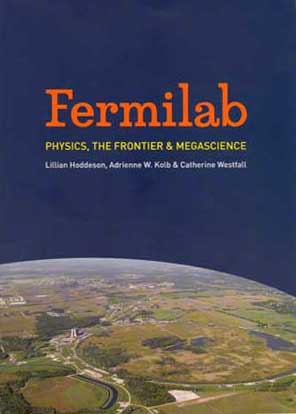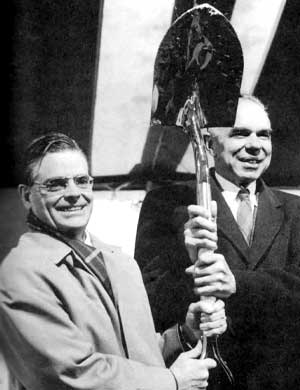New Books of Note
Fermilab: Physics, the Frontier & Megascience
By Lillian Hoddeson, Adrienne W. Kolb and Catherine Westfall
University of Chicago Press, 2008, photos and illustrations, 499+xiii pages, $45.00
Reviewed by Robert P. Crease
 The book Fermilab: Physics, the Frontier, and Megascience is a welcome addition to the growing literature on laboratories. It is the history of a laboratory that has been a key node in the US science network for close to four decades. The lab began life in 1967 as the National Accelerator Laboratory, or NAL, and in 1974 was renamed in honor of Enrico Fermi to become FNAL. Its centerpiece has always been a high-energy proton accelerator, starting with a 200 GeV fixed-target machine that switched on in 1970, followed by the Tevatron proton-proton collider, completed in 1987. The Tevatron will be the world’s most powerful particle accelerator until CERN’s Large Hadron Collider, or LHC, finally becomes fully operational later this year or next.
The book Fermilab: Physics, the Frontier, and Megascience is a welcome addition to the growing literature on laboratories. It is the history of a laboratory that has been a key node in the US science network for close to four decades. The lab began life in 1967 as the National Accelerator Laboratory, or NAL, and in 1974 was renamed in honor of Enrico Fermi to become FNAL. Its centerpiece has always been a high-energy proton accelerator, starting with a 200 GeV fixed-target machine that switched on in 1970, followed by the Tevatron proton-proton collider, completed in 1987. The Tevatron will be the world’s most powerful particle accelerator until CERN’s Large Hadron Collider, or LHC, finally becomes fully operational later this year or next.
Laboratories are not neutral spaces but complex and organized productive institutions that must take extraordinary risks while adhering to the bottom line. When effective, they seem to remain in the background, providing flexible support for researchers in mounting experiments. Yet to stay effective, national labs must periodically reinvent themselves in response to changing scientific developments, government interests, and budgetary realities. The complex fabric of elements—of people, instruments, departments, funding agencies, political interests, collaborating institutions, and so forth—that must interact to achieve this end makes labs difficult to write about. Thus the writing of the laboratory history, even more than histories of other institutions, requires carefully thought-out framing principles.
Fermilab: Physics, the Frontier, and Megascience includes some stories and images you might expect:

Robert Wilson and Glenn Seaborg at the Linac groundbreaking ceremony, December 1968 (Fig. 5.6, page 115)

The Master Plan for NAL (Fig. 5.9, page 118)

A bubble chamber photo from 1978 (Fig. 7.2, page 164)

But the book also includes some stories and images you might not expect. Meet Felicia the ferret (Fig. 6.3, page 150). Felicia was a Laboratory staff member in 1971:
“…construction debris cluttered the Main Ring vacuum tube. To examine this debris problem in the Meson Lab, the NAL staff tried to train a ferret, affectionately named Felicia, to drag a cleaning cloth through roughly 300 feet of vacuum tube…Frustrated by the length of her new tunnel, Felicia accepted an early retirement.” (p. 149)
All photos courtesy of FNAL Visual Media Services
Hoddeson is an award-winning professor of history at the University of Illinois at Urbana-Champaign, Kolb is the Fermilab archivist, and Catherine Westfall is visiting associate professor at Lyman Briggs College at Michigan State University and a historian of 20th century science. The authors announce their framing principles in the book’s subtitle: physics, the frontier, and megascience. They pick up the physics story at the beginning of the 1960s when the first alternating-gradient accelerators were completed, a development that incited the ambitions of physicists to soar to 1,000 GeV and beyond. At the time, two laboratories—Brookhaven and Berkeley—dominated US accelerator-building. In Part I the authors follow the complex story of the erosion of this dominance, and the evolution of a 200 GeV accelerator design. The lab was eventually sited in Weston, Illinois, with Robert R. Wilson as its first director.
The second framing principle—the frontier—comes into play in Part II. While the imagery of frontier exploration has long been significant in science, the authors write, it played a special role in forging and maintaining Fermilab’s special identity. Physically, the lab is a “frontier-like site”; institutionally, it is the “flagship” of a “voyage of exploration.” The authors admit it is an astounding coincidence that Wilson was born in a Wyoming town called Frontier, yet they take his persistent invocation of frontier imagery seriously. Drawing inspiration from Frederick Jackson Turner’s famous thesis, according to which the lure and image of the frontier have imbued Americans with a particular character, the authors claim that this image is also “a powerful tool” for understanding how science history is embedded within social history. Hoddeson and colleagues wield it, for instance, in describing the institutional formation of the lab’s first few years, when Wilson’s frontier vision collided with Big-Science realities during completion of the Main Ring, development of the experimental areas, and the staging of the first research. But the influence of the frontier image continued later on, the authors argue, as Wilson guided the laboratory in the first steps of an ambitious plan to use superconductivity in doubling the accelerator’s energy to a trillion electron volts, or 1 TeV.
Hoddeson and company do not develop the frontier metaphor as fully as they might have. Sometimes the language of the frontier seems an appropriate characterization of the force driving the scientists, while at other times the purpose of the rhetoric seems to be to cultivate the interest of politicians and the public. How much are the bison herds imported to graze on the Fermilab site a deep expression of the forces involved? And how much do they resemble the props of Disneyland’s Frontierland? More work needs to be done in unveiling the layers of meaning in this imagery before their historiographical tool can fully reveal its power.
The third framing principle of this book is megascience. The term has been around for years (as in the Megascience Forum of the Organization of Economic Cooperation and Development) to refer to large international projects whose scale has reached the next level beyond what we used to call Big Science. But the authors cleverly give the term a narrower definition, referring to what happened when Big Science began to be curtailed—to the impact on Big Science in the 1970s, when funding and resources began to shrink. In Part III they trace the effects of this shrinkage on the laboratory, after Wilson resigned and Leon Lederman stepped in to replace him. The impacts, they find, reached from the institutional structure to the shape of experimental traditions.
The authors use these three framing principles to keep the complex story of this laboratory in a more-or-less single narrative. This narrative integrates the main personalities and their accomplishments, although it occasionally passes over the conflicts between Fermilab and other institutions rather lightly. While Wilson’s penchant for risk-taking is ably conveyed, for instance, the fact that his resignation had been part of a gamble to gain more federal support for the lab is covered only in an appendix.
Today the LHC is poised to take over the mantle of the world’s most powerful accelerator. The LHC’s recent difficulties, in which a structural problem in the magnets has seriously delayed operations, postponing the research and costing large sums of money, are an eerie echo of Fermilab’s teething problems. This episode highlights the importance of understanding the tremendous pressures that beset such ambitious undertakings. This book makes an excellent contribution to that understanding.
Robert P. Crease is Chairman of the Department of Philosophy at Stony Brook University. He writes frequently about the history of physics, including in a regular column for Physics World. His most recent book is The Great Equations: Breakthroughs in Science from Pythagoras to Heisenberg (W. W. Norton, 2009).
Note Added: This article represents the views of the author, which are not necessarily those of the FHP or APS.
